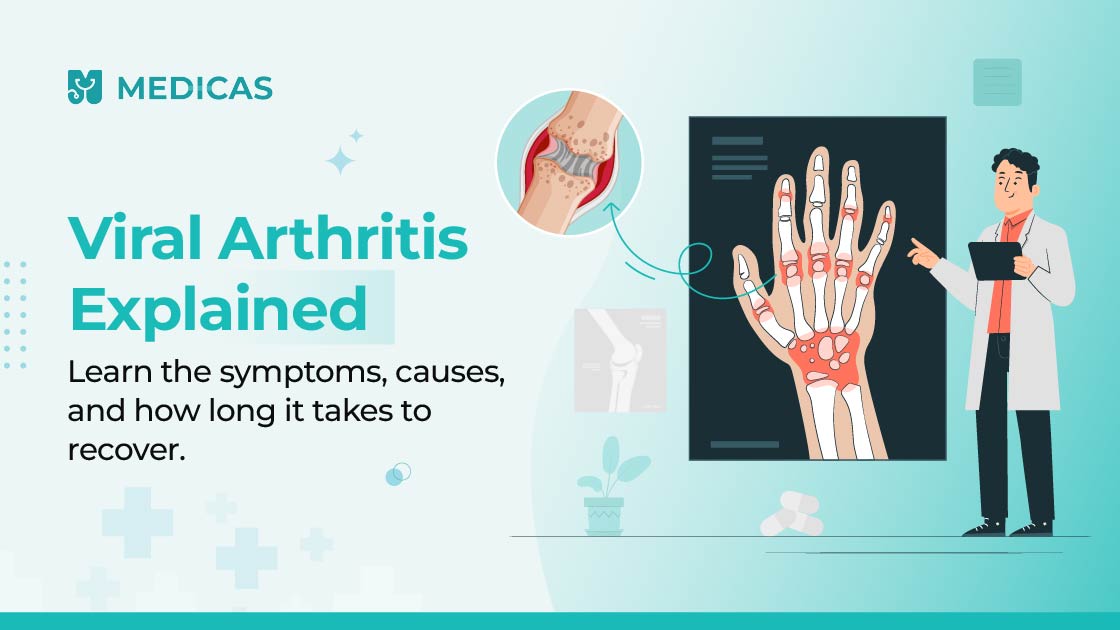Sometimes, even after your cold or flu is gone, your body isn’t quite done healing. If joint pain lingers or appears suddenly, viral arthritis could be the cause. Though it sounds intimidating, this type of arthritis is usually temporary and treatable. Let’s take a closer look at what it is, why it happens, and how you can manage it effectively.
Understanding Viral Arthritis
Viral arthritis is a temporary inflammation of the joints caused by a viral infection. It can affect people of any age and is usually self-limiting, resolving within a few weeks.
Causes of Viral Arthritis
The most common viral arthritis causes include infections such as:
| Virus | Commonly Associated Condition |
| Chikungunya | High fever, joint swelling, fatigue |
| Dengue | Fever, body pain, rash |
| Hepatitis B and C | Liver inflammation, joint pain |
| Parvovirus B19 | Mild fever, rash, joint pain |
These viruses can either directly invade the joint tissue or trigger an immune response that leads to inflammation.
How Viral Infections Affect Joints
When a virus circulates in the bloodstream, it can:
Directly Infect Synovial Cells
Some viruses replicate in joint tissues, causing local inflammation.
Trigger Immune Complex Formation
Viral antigens bind antibodies, depositing in joints and activating complement.
Release Cytokines
Systemic inflammation increases cytokines (e.g., IL-6, TNF-α), which sensitize pain receptors. This is why joint pain after viral fever is fairly common, especially in tropical regions where mosquito-borne infections are prevalent. For more indepth diagnosis of your condition, consult top orthopaedics near you via Medicas.
Common Symptoms of Viral Arthritis
The viral arthritis symptoms can vary depending on the virus and the individual’s immunity. Common complaints include:
- Pain in joints, especially knees, ankles, wrists
- Swelling and redness around the joints
- Low-grade or high fever
- Rash or skin irritation
- General fatigue or weakness
Diagnosing Viral Arthritis
Proper diagnosis is crucial, especially to differentiate it from autoimmune types of arthritis like rheumatoid arthritis.
Medical History and Physical Examination
A thorough history captures recent viral illness, travel, and joint pain after viral fever timeline. Physical exam assesses joint range, swelling, and warmth. Book an online doctor consultation with top orthopedic doctors near you.
Laboratory Tests
These include:
| Test | Purpose |
| CBC (Complete Blood Count) | To detect signs of infection |
| ESR & CRP | To measure inflammation levels |
| Viral serology | To identify the responsible virus |
| RA factor, ANA | To rule out autoimmune arthritis |
Treatment Options for Viral Arthritis
Treatment Options for Viral Arthritis
Viral arthritis is usually mild and self-resolving, improving as the viral infection clears. However, treatment is essential to manage pain, reduce inflammation, and improve joint mobility during the recovery phase.
Best Medicine for Viral Arthritis
Viral arthritis typically improves on its own, but medications help ease symptoms and improve quality of life. Here are the most commonly recommended treatment options:
| Medicine Type | Use |
| Non-Steroidal Anti-Inflammatory Drugs (NSAIDs) | Drugs like ibuprofen and naproxen help reduce pain and joint inflammation. These are often the first line of treatment for mild to moderate symptoms. |
| Analgesics (Pain Relievers) | Paracetamol or acetaminophen can be used when inflammation is minimal but pain or fever is present. |
| Corticosteroids | In cases where joint pain and swelling are severe or persistent, doctors might recommend low-dose corticosteroids like prednisone. These help reduce inflammation quickly but should always be taken under medical supervision. |
| Antiviral Medications | Used in specific cases where a known virus—like Hepatitis B or C—is causing the arthritis. Treating the virus can significantly reduce joint symptoms. |
Steroid treatment may be recommended when symptoms do not respond to NSAIDs or when inflammation is more widespread or intense. Always follow your doctor’s guidance for dosage and duration. Supportive and Lifestyle Care In addition to medications, supportive measures are key to a smooth recovery:
- Hydration: Helps flush out toxins and inflammatory mediators from the body.
- Rest: Minimizes joint stress and promotes healing.
- Gentle Exercises: Once the pain reduces, light stretching improves joint flexibility and reduces stiffness.
- Cold and Heat Therapy:
- Warm compresses relax muscles and increase blood flow.
- Cold packs reduce swelling and numb pain.
- Home Remedies: Drinking turmeric milk may provide natural anti-inflammatory effects.
If symptoms persist beyond a few weeks, book an appointment with Ortho specialists or opt for an online doctor consultation for proper assessment.
Recovery Timeline and Prognosis
So, how long does viral arthritis last?
| Condition | Recovery Time |
| Mild viral arthritis | 1-3 weeks |
| Moderate (post-chikungunya) | 4-6 weeks or more |
| Chronic post-viral arthritis | Up to 6 months (rare cases) |
In general, post-viral arthritis resolves over 2–6 weeks. Chronic cases are rare but warrant further evaluation.
When to Seek Further Medical Attention
Seek medical help if:
- Joint pain worsens or spreads
- Swelling becomes severe
- Fever returns
- Joints feel hot to the touch
In such cases, your doctor may suspect secondary infections or autoimmune reactions.
Preventing Viral Arthritis
While you cannot always avoid viruses, you can reduce the risk.
Vaccinations and Preventive Measures
Here’s how vaccinations and smart preventive measures can build your first line of defence:
- Stay updated with the MMR (Measles, Mumps, Rubella) vaccine and the hepatitis B vaccination
- Use mosquito repellents and nets
- Maintain hygiene and sanitation to avoid viral transmission
Strengthening Immune System
A robust immune system is your best defense against viral infections and, consequently, viral arthritis.
- Eat a balanced diet with immunity-boosting foods.
- Exercise regularly. For excellent tips on preventing common injuries and keeping your body strong, consider exploring “Stay in the Game: Your Ultimate Guide to Preventing Sports Injuries“.
- Get enough sleep
- Practice yoga, meditation to regulate immune responses.
What Is Autoimmune Arthritis and How Is It Different?
When discussing viral arthritis, it’s natural to wonder about its distinction from other types of arthritis, particularly autoimmune forms.
Post-Viral Arthritis vs Autoimmune Arthritis
While both can cause joint inflammation, their underlying mechanisms are quite different:
| Feature | Viral Arthritis | Autoimmune Arthritis (e.g., Rheumatoid Arthritis) |
| Cause | Triggered by a viral infection (immune response to the virus) | The immune system mistakenly attacks healthy joint tissues |
| Onset | Often acute, following a viral illness | Usually gradual and insidious |
| Duration | Weeks to months, then resolves | Lifelong unless treated |
| Joint Involvement | Often migratory; can be symmetrical or asymmetrical | Typically symmetrical; often affects small joints first |
| Presence of Antibodies | Viral antibodies may be present | Autoantibodies (e.g., RF, ACPA, ANA) are often present |
| Treatment Focus | Supportive care: NSAIDs, rest, physical therapy if needed | Long-term management: DMARDs, corticosteroids, biologics, lifestyle changes |
| Prognosis | Generally good; often complete resolution | Requires ongoing treatment to prevent flares and joint damage |
Conclusion
Viral arthritis may disrupt daily life, but with timely diagnosis, symptom-focused treatment, and supportive care, most recover fully within weeks. If you have unexplained joint pain, fever, or fatigue, book an appointment with a specialist through Medicas to get examined. For suspected infections, you can also book lab test for quick diagnosis. You can also consult with me directly via Medicas.
Frequently Asked Questions
- What is viral arthritis?
Viral arthritis is joint inflammation triggered by a viral infection (e.g., chikungunya, dengue). It causes pain, swelling, and stiffness, usually resolving within weeks.
- How long does viral arthritis last?
It depends on the virus and individual immunity. Most people recover within 2–4 weeks, though some may experience pain for longer.
- Is joint pain after a viral fever normal?
Yes. Joint pain after fever is normal in infections like dengue. If pain persists beyond a month or worsens, seek evaluation via book lab test or orthopaedic consultation.
- What is the best treatment for viral arthritis?
NSAIDs, adequate rest, hydration, and mild stretching help in most cases. Antiviral drugs may be used if needed, especially in hepatitis-related cases.
- When should I see an orthopaedic doctor for viral arthritis?
If pain continues beyond 4 weeks, joints are severely swollen, or fever returns, consult an orthopaedic specialist. Don’t ignore prolonged joint discomfort.
- How is autoimmune arthritis treated differently from post-viral arthritis?
Autoimmune arthritis like rheumatoid arthritis typically requires long-term treatment to control the overactive immune response. This may include DMARDs (Disease-Modifying Antirheumatic Drugs) such as methotrexate, biologic therapies, corticosteroids, and regular monitoring. In contrast, post-viral arthritis is often self-limiting, with treatment focused on symptom relief through NSAIDs, rest, and physical therapy if needed. Identifying the type of arthritis is crucial for appropriate management and better outcomes.
Disclaimer
Medical Advice: The information provided in this blog post is for educational purposes only and should not be considered as a substitute for professional medical advice, diagnosis, or treatment. Always consult with a qualified healthcare professional for personalized guidance regarding your specific medical condition.
Accuracy of Information: While we strive to provide accurate and up-to-date information, the field of medicine and viral fevers is constantly evolving. The content in this blog post may not reflect the most current research or medical guidelines. Therefore, it is advisable to cross-check any information provided with reliable sources or consult a healthcare professional.
Individual Variations: The symptoms, causes, treatment options, and preventive measures discussed in this blog post are general in nature and may not apply to everyone. It is important to remember that each individual’s situation is unique, and personalized medical advice should be sought when making healthcare decisions.
External Links: This blog post may contain links to external websites or resources for additional information. However, we do not endorse or have control over the content of these third-party websites. Accessing these links is done at your own risk, and we are not responsible for any consequences or damages that may arise from visiting these external sources.
Results May Vary: The effectiveness of treatment options or preventive measures mentioned in this blog post may vary from person to person. What works for one individual may not work the same way for another. It is essential to consult with a healthcare professional for personalized advice tailored to your specific needs.



